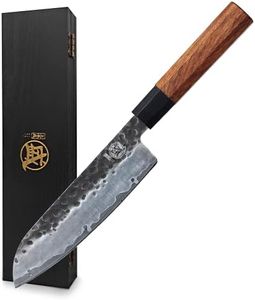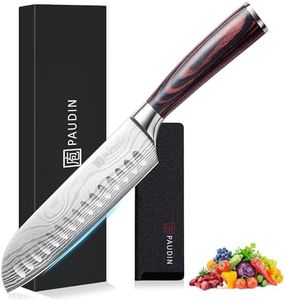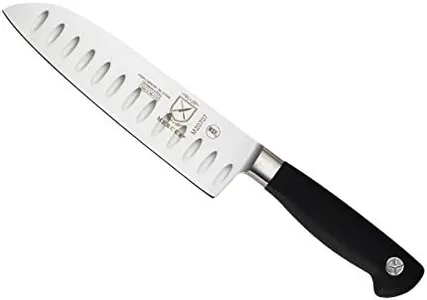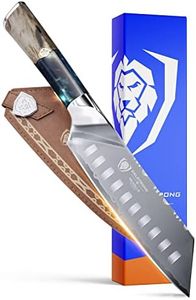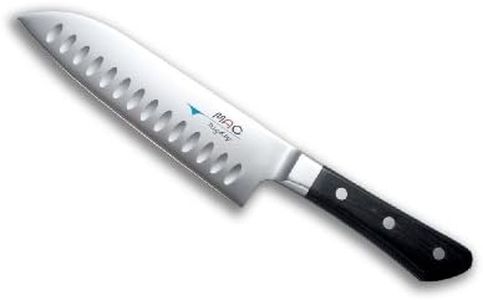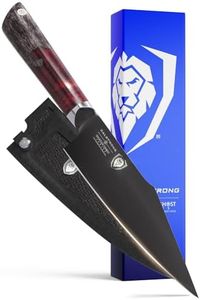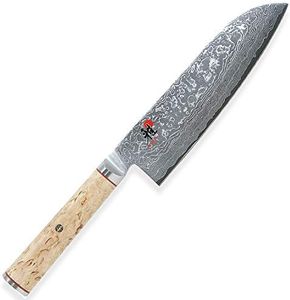We Use CookiesWe use cookies to enhance the security, performance,
functionality and for analytical and promotional activities. By continuing to browse this site you
are agreeing to our privacy policy
10 Best Santoku Knife
From leading brands and best sellers available on the web.Buying Guide for the Best Santoku Knife
Choosing the right Santoku knife can make a big difference in your cooking experience. A Santoku knife is a Japanese-style all-purpose kitchen knife, known for its versatility and ease of handling, making it suitable for slicing, dicing, and chopping a variety of ingredients. When picking the best Santoku knife for you, it helps to understand some important features and how they affect the knife's performance in daily use. Think about how you cook, what feels comfortable in your hand, and what types of foods you most often prepare. Understanding these key specs will help you make an informed decision.Blade LengthBlade length refers to how long the actual cutting edge of the knife is. This is important because it determines how much control you have and what size foods you can comfortably cut. Santoku knives usually come in lengths from about 5 to 7 inches. Blades around 5 inches are more maneuverable and lighter, great for smaller hands or precise work like chopping herbs and small vegetables. Around 6 to 7 inches offers more versatility for tasks like slicing larger vegetables, meats, or even fish. Choose a smaller blade if you value agility and control, or a longer blade for all-around use and dealing with bigger ingredients.
Blade MaterialBlade material affects the knife's sharpness, durability, and ease of maintenance. The most common materials are stainless steel, high-carbon steel, and sometimes ceramic. Stainless steel blades are rust-resistant and easy to maintain, which is great for everyday users who don't want to fuss over their knife. High-carbon steel tends to stay sharper for longer and can be easier to sharpen, but may require extra care to avoid rusting. Ceramic blades stay sharp for a long time and are very light, but can chip or break if dropped. Consider your willingness to maintain the blade and what performance traits you value—go for stainless if you want convenience, high-carbon for sharpness, or ceramic for ultra-light and long-lasting sharpness.
Handle Comfort and MaterialThe handle is where comfort meets safety—it's what you grip for control. Handles come in various materials like wood, plastic, or composite, each offering a different feel and durability. Wooden handles have a classic, natural feel and good grip, but may require more care to avoid splitting or bacteria build-up. Plastic or composite handles are durable and often shaped ergonomically for comfort, and they're generally lower-maintenance. Comfort is subjective, so it's important to pick a handle that feels good in your hand and provides a non-slip grip, especially if your hands get wet or greasy during cooking. Choose a handle based on your preference for feel, appearance, and how much maintenance you're willing to do.
Blade Edge StyleSantoku knives often feature either a plain (straight) edge or a 'granton' edge, which has small dimples or scallops along the blade. Edge style impacts how well food releases from the blade. A plain edge is straightforward and easy to sharpen, ideal if you want no-fuss maintenance. A granton edge helps minimize sticking when slicing foods like potatoes or cheese, which can make prep work faster and cleaner. Consider a granton edge if you often prep sticky or starchy foods, but if you want easier sharpening, stick with a plain edge.
Weight and BalanceThe overall weight and balance of a Santoku knife influence how tiring it is to use and how much control you have. Heavier knives provide more cutting power with less effort but can be tiring if you chop for long periods. Lighter knives are easier to maneuver and great for fast, repetitive tasks. Balance refers to where the knife's weight is centered—ideally, it should feel evenly balanced between the handle and blade for comfort and control. Think about how long you tend to spend cutting and what feels natural to you; test a few if possible and see if you prefer a heavier, more solid feel or a lighter, nimbler one.
